
Astronomers have discovered what they believe is the earliest and most distant galaxy in the universe, which could be home to the very first stars in existence, by using the biggest telescopes on Earth.
The cosmic body appears to be a reddish blob that scientists have named HD1 and is thought to have poured prodigious amounts of energy only 330 million years after the Big Bang. The moments of time when the universe was still young have so far remained mysterious and unexplored. Another blob that scientists discovered, which was named HD2, appeared nearly as far as the other galaxy.
Farthest Galaxy
However, experts can only guess and theorize about what these celestial objects are, with the most prominent proposals being galaxies or quasars, but they could be something else entirely. Astronomers will have to wait until the new James Webb Space Telescope provides more information regarding the blobs.
Astronomers argue that, whatever they are, the discovery could provide significant information regarding the cosmos and the crucial phase where it evolved from pristine primordial fire into planets, life, and eventually, us, as per the New York Times.
The people who discovered the cosmic body are an international team of astronomers who include researchers at the Center for Astrophysics | Harvard & Smithsonian. HD1 is roughly 13.5 billion light-years away from our planet.
The team also proposed two ideas of what the blob could be, which include forming stars that could be home to Population III stars, which are what they call the universe's first stars. On the other hand, it could also be home to a supermassive black hole that is roughly 100 million times the mass of our Sun.
Amazing Discovery
According to Phys.org, the lead author of the MNRAS study, Fabio Pacucci, who is also a co-author in the discovery paper on ApJ and an astronomer at the Center for Astrophysics, said it has always been challenging to answer questions about the nature of a source so far away from us. He argued it was similar to guessing the nationality of a ship from the flag it flies while being far away ashore, with the vessel in the middle of a gale and dense fog.
In an interview, study researcher and Harvard astrophysicist Avi Loeb said that the first galaxies formed roughly a hundred million years after the events of the Big Bang. They are believed to have had a millionth of the mass of the Milky Way and were much denser than our galaxy.
Loeb added that one way to think of the earliest galaxies was that they were building blocks in the construction project of present-day galaxies. The researchers discovered HD1 inside data collected over 1,200 hours of observation time from the Subaru Telescope, the VISTA Telescope, the UK Infrared Telescope, and the Spitzer Space Telescope.
The professionals were trying to look at redshift, which is a phenomenon where light waves stretch out or become redder as an object moves away from the observer. The hue of the redshift suggested that HD1 was extremely far from our planet, LiveScience reported.
Related Article:
NASA Hubble Image Shows Stunning View of Farthest Star Seen; Is it Also the Oldest?








